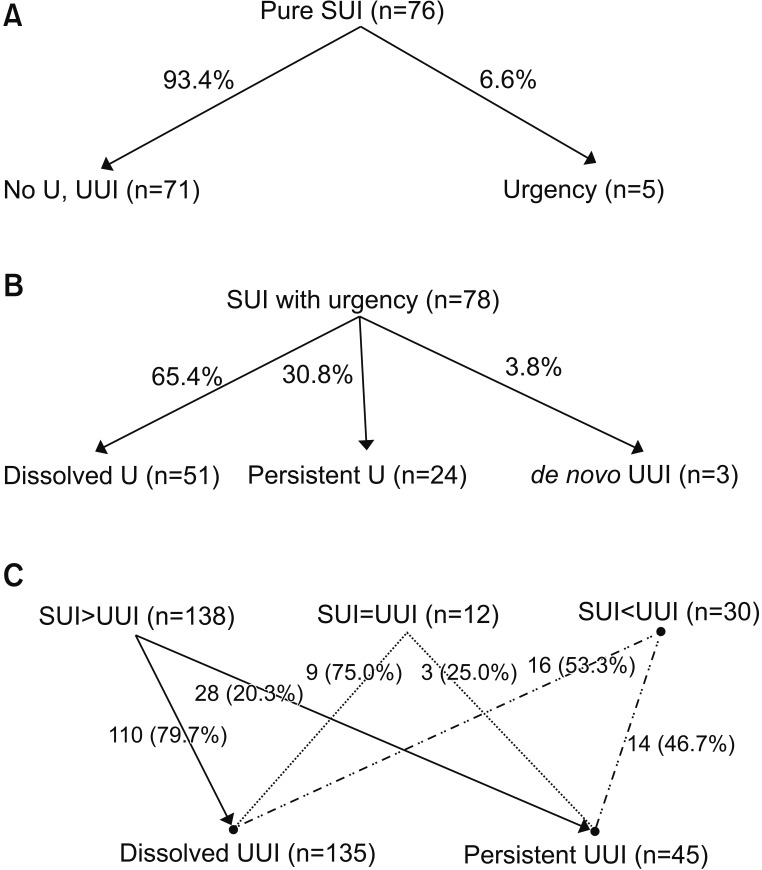Investig Clin Urol.
2019 Sep;60(5):373-379. 10.4111/icu.2019.60.5.373.
De novo or resolved urgency and urgency urinary incontinence after midurethral sling operations: How can we properly counsel our patients?
- Affiliations
-
- 1Department of Urology, Asan Medical Center, University of Ulsan College of Medicine, Seoul, Korea. mschoo@amc.seoul.kr
- KMID: 2455965
- DOI: http://doi.org/10.4111/icu.2019.60.5.373
Abstract
- PURPOSE
To evaluate de novo and resolved urgency and urgency urinary incontinence (UUI) after midurethral sling operations in patients with stress urinary incontinence (SUI) and mixed urinary incontinence (MUI).
MATERIALS AND METHODS
Patients who underwent midurethral sling operations because of SUI and MUI between January 2012 and December 2016 were reviewed. Patients were divided into three groups (pure SUI, SUI with urgency, and MUI). Patients with MUI were subcategorized as SUI predominant, equivalent, and UUI predominant. Postoperative de novo, persistent or disappearance of urgency or UUI were compared.
RESULTS
A total of 334 patients were included: 76 with pure SUI, 78 with SUI with urgency, and 180 with MUI. In the MUI group, 138 patients were SUI predominant, 12 patients were equivalent, and 30 patients were UUI predominant. De novo urgency developed in 5 patients (6.6%) in the pure SUI group. In the SUI with urgency group, 51 patients (65.4%) became urgency-free, and 3 (3.8%) developed de novo UUI. UUI resolved in 135 patients (75.0%): 110 (79.7%) in the SUI-predominant group, 9 (75.0%) in the equivalent group, and 16 (53.3%) in the UUI-predominant group. The patients' preoperative perception of predominant UUI was the predictive factor for persistent UUI in the multivariate analysis (hazard ratio, 5.722; p=0.001).
CONCLUSIONS
De novo urgency and UUI developed in a relatively small number of patients after a midurethral sling operation. The resolution rate of UUI was significantly low in patients who had previous pelvic surgery or who preoperatively perceived UUI as a more bothersome symptom.
MeSH Terms
Figure
Reference
-
1. Luber KM. The definition, prevalence, and risk factors for stress urinary incontinence. Rev Urol. 2004; 6 Suppl 3:S3–S9.2. Agarwal MM, Mavuduru R, Singh SK. Safety and efficacy of transobturator tension-free midurethral sling for surgical management of stress urinary incontinence in women. Int Urogynecol J Pelvic Floor Dysfunct. 2008; 19:893–894. PMID: 18000632.
Article3. Brubaker L, Lukacz ES, Burgio K, Zimmern P, Norton P, Leng W, et al. Mixed incontinence: comparing definitions in non-surgical patients. Neurourol Urodyn. 2011; 30:47–51. PMID: 21181960.
Article4. Tang DH, Colayco D, Piercy J, Patel V, Globe D, Chancellor MB. Impact of urinary incontinence on health-related quality of life, daily activities, and healthcare resource utilization in patients with neurogenic detrusor overactivity. BMC Neurol. 2014; 14:74. PMID: 24708598.
Article5. Jain P, Jirschele K, Botros SM, Latthe PM. Effectiveness of midurethral slings in mixed urinary incontinence: a systematic review and meta-analysis. Int Urogynecol J. 2011; 22:923–932. PMID: 21455757.
Article6. Pergialiotis V, Mudiaga Z, Perrea DN, Doumouchtsis SK. De novo overactive bladder following midurethral sling procedures: a systematic review of the literature and meta-analysis. Int Urogynecol J. 2017; 28:1631–1638. PMID: 28780649.
Article7. Marcelissen T, Van Kerrebroeck P. Overactive bladder symptoms after midurethral sling surgery in women: risk factors and management. Neurourol Urodyn. 2018; 37:83–88. PMID: 28631830.
Article8. Song C, Park SH, Han JY, Lee KS, Choo MS. Identification of the optimal time to treat urgency after a midurethral sling procedure for stress urinary incontinence. Int Urogynecol J Pelvic Floor Dysfunct. 2008; 19:573–576. PMID: 17909690.
Article9. Mathias SD, Crosby RD, Nazir J, Klaver M, Drogendijk T, Hakimi Z, et al. Validation of the Patient Perception of Intensity of Urgency Scale in patients with lower urinary tract symptoms associated with benign prostatic hyperplasia. Value Health. 2014; 17:823–829. PMID: 25498777.
Article10. Tommaselli GA, Di Carlo C, Formisano C, Fabozzi A, Nappi C. Medium-term and long-term outcomes following placement of midurethral slings for stress urinary incontinence: a systematic review and metaanalysis. Int Urogynecol J. 2015; 26:1253–1268. PMID: 25990203.
Article11. Chun JY, Song M, Yoo DS, Han JY, Hong B, Choo MS. A comparative study of outside-in and inside-out transobturator tape procedures for female stress urinary incontinence: 7-year outcomes. Low Urin Tract Symptoms. 2014; 6:145–150. PMID: 26663595.
Article12. Khullar V, Cardozo L, Dmochowski R. Mixed incontinence: current evidence and future perspectives. Neurourol Urodyn. 2010; 29:618–622. PMID: 20432324.
Article13. Abdel-Fattah M, Cao G, Mostafa A. Long-term outcomes for transobturator tension-free vaginal tapes in women with urodynamic mixed urinary incontinence. Neurourol Urodyn. 2017; 36:902–908. PMID: 28028822.
Article14. Athanasiou S, Grigoriadis T, Giannoulis G, Protopapas A, Antsaklis A. Midurethral slings for women with urodynamic mixed incontinence: what to expect? Int Urogynecol J. 2013; 24:393–399. PMID: 22777582.
Article
- Full Text Links
- Actions
-
Cited
- CITED
-
- Close
- Share
- Similar articles
-
- The Change of Urgency and Effect on Patient Satisfaction after Sling Operations for Stress Urinary Incontinence
- The evolution of incontinence into resolved, refractory and de novo urgency urinary incontinence following sling placement at time of prolapse repair in a large urodynamic cohort
- Follow-up Results Exceeding 3 Years of Anterior Vaginal Wall Sling Operation for Female Patients with Stress Urinary Incontinence
- The Effect of Anticholinergic Drug Treatment before a Midurethral Sling Operation in Mixed Urinary Incontinence
- The Comparison of Long Term Outcome after Burch and Stamey Operation in Stress Urinary Incontinence Patients


